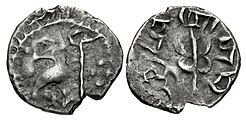Brahmin dynasty of Sindh
Brahmin dynasty | |||||||||
|---|---|---|---|---|---|---|---|---|---|
| 634–712 | |||||||||
| Capital | Aror | ||||||||
| Common languages | Sanskrit,Sindhi | ||||||||
| Religion | Hinduism | ||||||||
| Government | Monarchy | ||||||||
| Maharaja | |||||||||
• 632–671 | Chach | ||||||||
• 671–679 | Chandar | ||||||||
• 695–712 | Dahir | ||||||||
| History | |||||||||
• Chach founds the dynasty | 632 634 | ||||||||
• Annexed by theUmayyad Caliphate | 724 712 | ||||||||
| |||||||||
| Today part of | Pakistan India Iran | ||||||||

TheBrahmin dynasty(c. 632–712),[2]also known as theChacha dynasty[3]orSilaij dynasty,[4]was aHindu[5]dynasty that ruled theSindhregion, succeeding theRai dynasty.Most of the information about its existence comes from theChach Nama,a historical account of the Chach-Brahmin dynasty.[6]
The members of the dynasty continued to administer parts of Sindh under the Umayyad Caliphate'sCaliphal province of Sindafter itfell in 712.[2]These rulers include Hullishāh and Shishah.[2]
History
[edit]The dynasty was founded by aBrahminnamedChach of Arorafter he married the widow ofRai Sahasi IIand usurped the Buddhist Rai dynasty. His claim was further secured by the killing of Rai Sahasi II's brother.[2][7]
The casus belli for the Ummayad invasion was Sindhi pirates seizing tribute sent from the king of Serendib to the Ummayad Caliph. For the campaign CaliphAbd al-Malik ibn Marwangranted a large army to the governorAl-Hajjaj ibn Yusuf,but no attempt was made to annex Sindh due to the caliph's death. Under his son and successorAl-Walid I,the generalMuhammad bin Qasimled Islamic invasion of Sindh in 712.
During the conflict local Buddhist clans who maintained loyalty to the previous Rai dynasty such as the Jats, allied themselves with the Ummayads against Dahir. The lastHinduking of SindhRaja Dahirwas killed during the battle of Aror and Sindh was annexed into the Ummayad Caliphate.[8]
Rulers
[edit]The known rulers of the Brahmin dynasty are:[2]
Under theUmayyad Caliphate:
- Dahirsiya (r. c. 679– c. 709–fromBrahmanabad)
- Hullishāh (r. c. 712– c. 724–)
- Shishah (r. 724–)
-
Sindh. Chach of Alor. Pracandendra. Circa 632-671 CE. AR Damma (11mm, 0.64 g, 2h).Obverse:Crowned head right; swastika to right.Reverse:Large trident
-
Sindh. Multan. ‘Śri Tapana’. Circa 675-700 CE. AR Damma (12mm, 0.62 g, 8h) Head right; śri in Brahmi on forehead Stylized fire altar surmounted by three pellets; tapan and rja in Brahmi around
External links
[edit]See also
[edit]References
[edit]- ^Schwartzberg, Joseph E. (1978).A Historical Atlas of South Asia.Chicago: University of Chicago Press. p. 146, map XIV.2 (b).ISBN0226742210.
- ^abcdeWink, André (1991).Al- Hind: The Slave Kings and the Islamic Conquest.Brill. pp. 152–153.ISBN9004095098.
- ^Rao, B. S. L. Hanumantha; Rao, K. Basaveswara (1958).Indian History and Culture.Commercial Literature Company. p. 337.
- ^MacLean, Derryl N. (19 July 2021). Fleet, Kate; Krämer, Gudrun; Matringe, Denis; Nawas, John; Stewart, Devin J. (eds.)."Arūr".Encyclopaedia of Islam Three Online.Brill academic.doi:10.1163/1573-3912_ei3_com_23005.ISSN1573-3912.
- ^Shaikh, Muhammad Ali."History of Sindh, before the arabs arrived".asianews.network.Retrieved2024-08-30.
- ^Keay, John (1999).India: A History.London: HarperCollins. pp. 182–183.ISBN978-0-00-255717-7.
- ^MacLean, Derryl N. (1989).Religion and Society in Arab Sind.Brill.ISBN9004085513.
- ^Burton, Richard (1851).Sindh and the Races that Inhabit the Valley of the Indus.Asian Educational Services. pp. 14–15.ISBN9788120607583.



